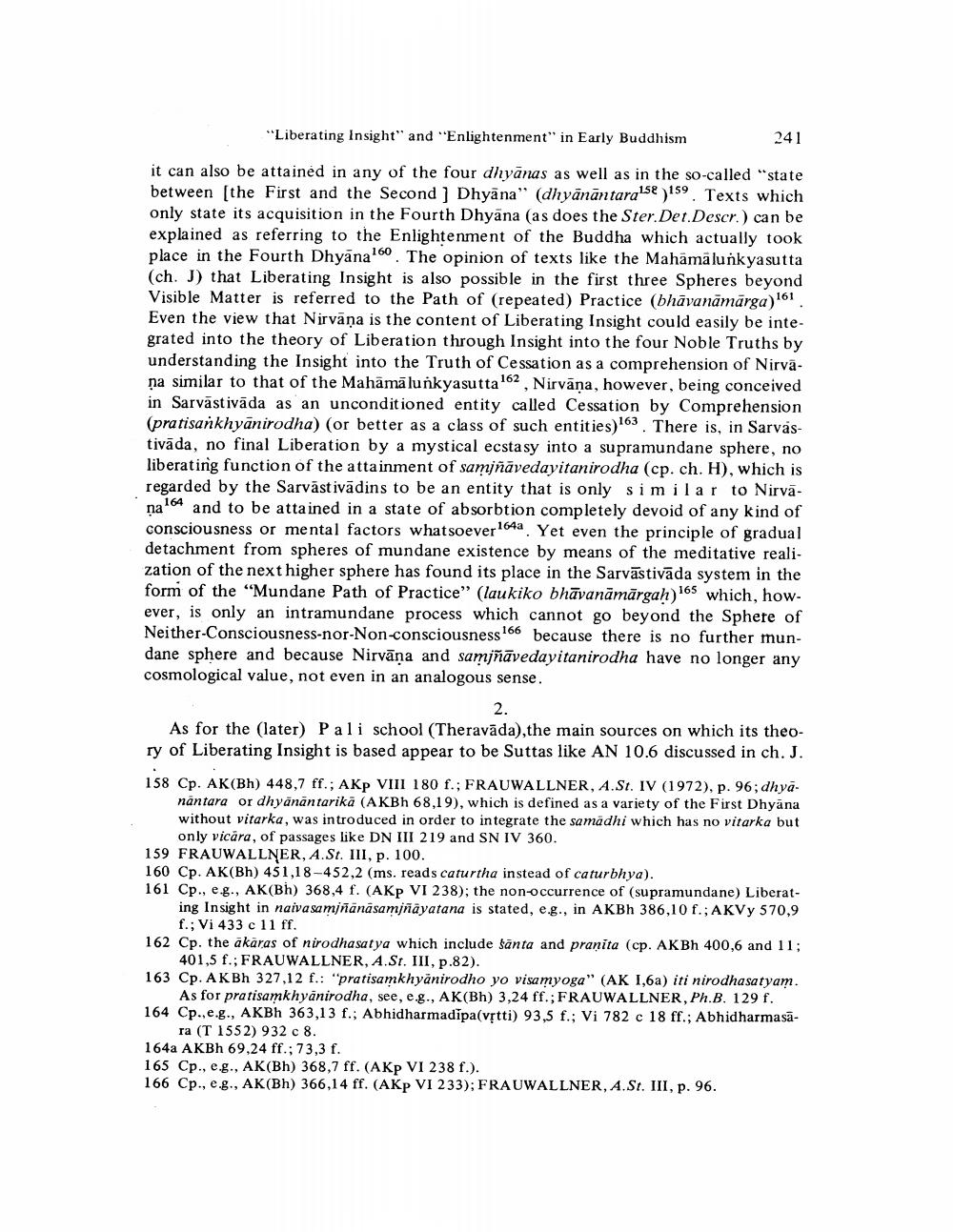Book Title: Alt Und Neu Undische Studien Author(s): Hearusgegeben Vom Publisher: Hearusgegeben Vom View full book textPage 2
________________ "Liberating Insight" and Enlightenment" in Early Buddhism 241 it can also be attained in any of the four dhyānas as well as in the so-called "state between the First and the Second | Dhyāna" (dhyānāntara1se)"59. Texts which only state its acquisition in the Fourth Dhyāna (as does the Ster. Det.Descr.) can be explained as referring to the Enlightenment of the Buddha which actually took place in the Fourth Dhyana 60. The opinion of texts like the Mahamálunkyasutta (ch. J) that Liberating Insight is also possible in the first three Spheres beyond Visible Matter is referred to the Path of (repeated) Practice (bhāvanāmārga) . Even the view that Nirvana is the content of Liberating Insight could easily be integrated into the theory of Liberation through Insight into the four Noble Truths by understanding the Insight into the Truth of Cessation as a comprehension of Nirvana similar to that of the Mahämälunkyasutta 62, Nirvāna, however, being conceived in Sarvāstivāda as an unconditioned entity called Cessation by Comprehension (pratisankhyānirodha) (or better as a class of such entities)63. There is, in Sarvastivāda, no final Liberation by a mystical ecstasy into a supramundane sphere, no liberating function of the attainment of samjñāvedayitanirodha (cp. ch. H), which is regarded by the Sarvāstivādins to be an entity that is only similar to Nirvana164 and to be attained in a state of absorbtion completely devoid of any kind of consciousness or mental factors whatsoever 1641. Yet even the principle of gradual detachment from spheres of mundane existence by means of the meditative realization of the next higher sphere has found its place in the Sarvāstivāda system in the form of the "Mundane Path of Practice" (laukiko bhāvanāmārgah) 165 which, however, is only an intramundane process which cannot go beyond the Sphere of Neither-Consciousness-nor-Non-consciousness66 because there is no further mundane sphere and because Nirvāṇa and samjñāvedayitanirodha have no longer any cosmological value, not even in an analogous sense. 2. As for the (later) Pali school (Theravāda), the main sources on which its theory of Liberating Insight is based appear to be Suttas like AN 10.6 discussed in ch. J. 158 CP. AK(Bh) 448,7 ff.; AKP VIII 180 f.; FRAUWALLNER, A.St. IV (1972), p. 96; dhya nantara or dhyanan tarika (AKBh 68,19), which is defined as a variety of the First Dhyana without vitarka, was introduced in order to integrate the samadhi which has no vitarka but only vicára, of passages like DN III 219 and SN IV 360. 159 FRAUWALLNER, A.St. III, p. 100. 160 CP. AK(Bh) 451,18-452,2 (ms. reads caturtha instead of caturbhya). 161 Cp., e.g., AK(Bh) 368,4 f. (AKP VI 238); the non-occurrence of (supramundane) Liberat ing Insight in naiva samiñanasamjñāyatana is stated, e.g., in AKBh 386,10 f.; AKVy 570,9 f.; Vi 433 c 11 ff. 162 Cp. the akaras of nirodhasat ya which include sānta and pranita (cp. AKBh 400,6 and 11; 401,5 f.; FRAUWALLNER, A.St. III, p.82). 163 CP. AK Bh 327,12 f.: "pratisamkhyanirodho yo visamyoga" (AK 1,6a) iti nirodhasatyam. As for pratisamkhyanirodha, see, e.g., AK(Bh) 3,24 ff.; FRAUWALLNER, Ph.B. 129 f. 164 Cp..e.g., AKBh 363,13 f.; Abhidharmadipa(vrtti) 93.5 f.; Vi 782 c 18 ff.; Abhidharmasa ra (T 1552) 932 c 8. 164a AKB 69,24 ff.; 73,3 f. 165 Cp., c.g., AK(Bh) 368,7 ff. (AKP VI 238 f.). 166 Cp., c.g., AK(Bh) 366,14 ff. (AKP VI 233); FRAUWALLNER, A. St. III. p. 96.Page Navigation
1 2 3 4 5 6 7 8 9 10 11
